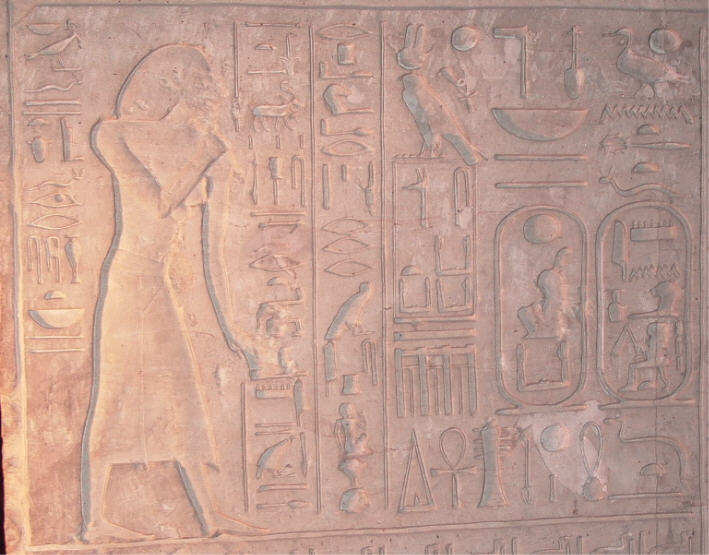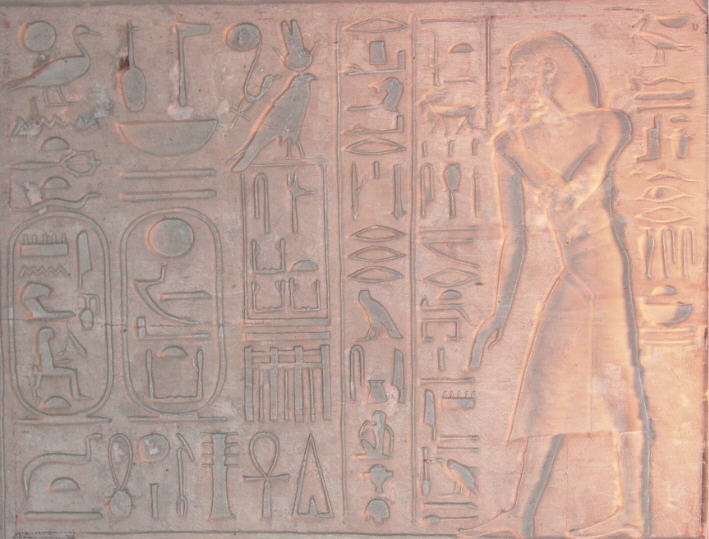 |
Senenmut |
last update:
19.12.2008
|
TT353
|
TT353, the second monument built by Senenmut, was discovered during the excavation season 1926/27 in January
1927 by H. E. Winlock. The entrance of the tomb is located hidden in the western corner of a
large quarry, which is called today "The Quarry of Senenmut".
This quarry served in antiquity to provide material for the causeway to Djeser djeseru.
Registered nowhere and covered by sand and debris in later times, TT353
was forgotten. |
| Winlock discovered TT353 coincidentally, when he examined the northern process of the
enclosure-wall built around the Mortuary Temple of Mentuhotep Nebhepetra.
Following that wall he discovered the tomb of Inyotef (= Antef = Intef) located on the lower terrace
of the temple of Hatshepsut, the tomb of queen Neferu, several remainders from mud brick
walls built by Amenhotep I., four shaft tombs from the 3. period, and, altogether, 7
foundation deposits of Hatshepsut. During this action he came also to the northeast corner the
district of Djeser
djeseru. A little bit outside of the holy district of Djeser djeseru
there is a
quarry (s. also the map with the Locations
of the tombs of Senenmut), in whose center a large heap of debris was
left by Naville during his "excavations" in the temple of
Hatshepsut in the years 1893 - 1899.
|
|
As a precaution Winlock decided to examine the part of the quarry between the heap of debris
left by Naville and district of Djeser djeseru - most likely he had the intention of storing
his own excavation debris there. The entrance of TT353 was closed
with mud-bricks (see the following picture) and the tomb itself unfinished and completely empty.
|
|
Unfortunately again the information about this excavation is rather unsatisfactory
. Beside the excavation reports published by Winlock further publications
exist (for example, several ostraca, which had been found in the quarry, were published by
Hayes). Furthermore, the information given in publications of other
authors is not consistent with the information published by
Winlock and also not with the data found in his unpublished records. The filed
records are - as judged by Dorman (1991) -
"remarkably" poor, a journal with records of the daily executed
work does not exist. The important "records" seem to have been written
in 1928, i.e. 1 year after the excavation. However, during the excavations their progress was photographically documented by Harry Burton. Only
few of the photos are dated, but their temporal sequence could be
reconstructed - an inestimable assistance in view of the poorly written
records.
|
| The described lack in the documentation inevitably leads to problems with the dating of the commencement of construction of
TT353, which is
dated into or around regnal year 16 of Hatshepsut. The dating of the commencement of construction of
TT353 is
of important interest, because this date is repeatedly used in the
discussion about the life span of princess Neferu-Ra. The discussion
about the dating of the commencement of construction of TT353 is
summarized on its own page. |
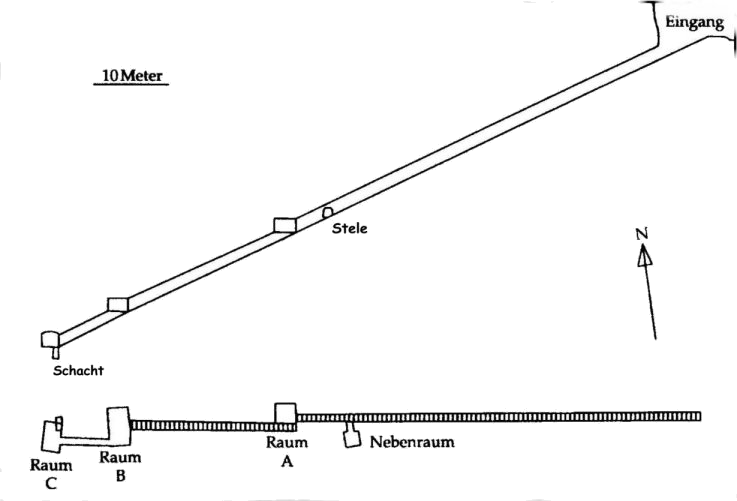
|
Floor plan of tomb TT353 (see also Dorman, 1991, or
Tyldesley, 1996)
|
| Eingang |
Entrance |
| Stele |
Stela |
| Nebenraum |
Side-Chamber |
| Raum A |
Chamber A |
| Raum B |
Chamber B |
| Raum C |
Chamber C |
| Schacht |
Shaft |
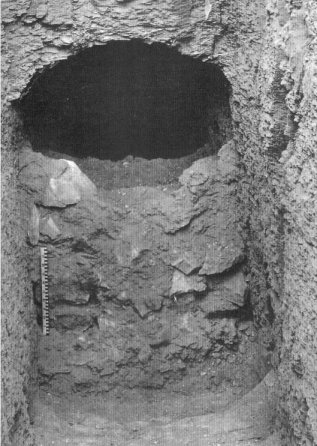
| Above the entrance of TT353, the photo was
taken during the excavation; it clearly shows the level of debris (photo
taken from Dorman, 1991) |
| TT353 consists of three long, linear descending
passageways and three chambers (A - C), which were completely cut out of the rock.
The last chamber C contains a shaft.
|
| The first passageway (from the entrance to the
Chamber A) is approx. 61 m long,
98 flat, roughly cut and irregular shaped stairs descend to Chamber A. The
uppermost stair is cut about 6,4 m behind the entrance, the slope of the
passageway is approx. 25°. About 58 m from the entrance on the left side of the
stairs is a small, irregularly formed side-Chamber cut out of the limestone.
Just a few stairs below this Chamber a round-topped niche is cut into the wall.
On the opposite wall - on the right page of the stairs - a small area
was smoothed in the rock in the shape of a round-topped stela (see
also "TT71 - Rock-cut Stelae Senenmut's"). This
"stela" shows the well-known ink sketch of Senenmut (see main page
Tombs).
|
| The first chamber A is still outside the holy district of the
temple of Hatshepsut but the two following are located under her courtyard. |
|
Chamber A is the only decorated room in the entire tomb. The walls were carefully smoothed and the
faults were filled with white mortar. The decoration of all walls and
those at the ceiling has been completed. The fact, that Chamber A had been
the only decorated room, has led to the assumption that originally the
tomb was planned to end up with this chamber, and all following stairways and
Chambers are a later extension. The most remarkable decoration items of the
chamber are the astronomical ceiling (see below) and a false-door stela on the west wall (see the following figure), which obviously
should imitate completely a free standing construction.
|
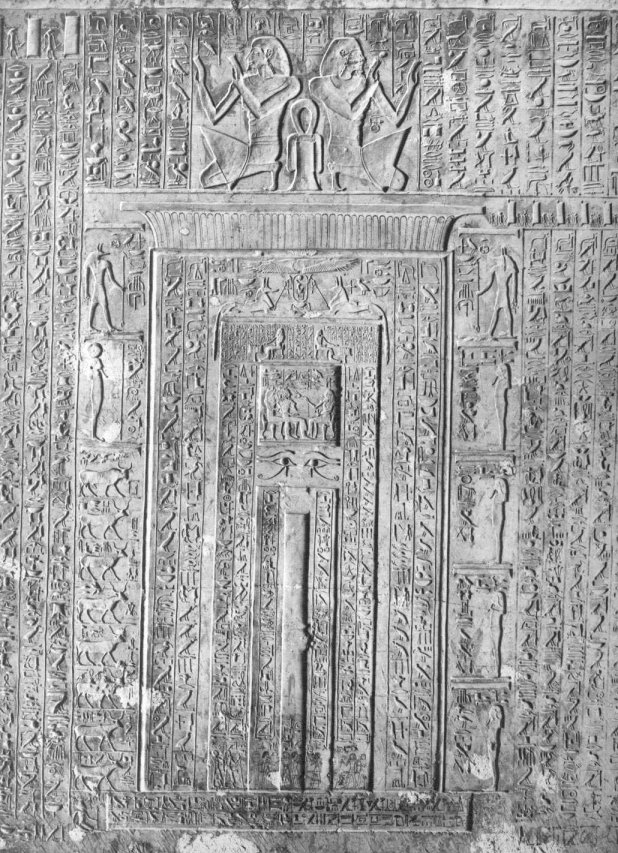
The false-door stela carved into the western wall of Chamber
A, looks almost identical to the one found in TT71.
Again, the decoration shows the facade of a chapel with a torus molding and and
crowned by a cavetto cornice like the false-door stela found in TT71. Several jambs form a false-door in the center. The stela is inscribed with
Chapter 148 of the Book of Dead. On either side it is decorated with
deities associated with this text: on the right exterior Anubis (top of
the row) and the four mummiform rudders of heaven, on the left exterior
again Anubis, below him the Sun God followed by the bull and the 7 cows of the
Sun God.
|
Above the false-door a funeral banquet
scene shows Senenmut and his parents. As already seen on the
false-door stela from tomb TT71 Senenmut is shown sitting between his
parents, behind him his father, who embraces him, and opposite to him
his mother, who holds
a lotus flower to his nose. Above the banquet-scene with his parents Senenmut
is shown twice in opposite representations sitting at a dinner-table.
Above the false-door Senenmut himself is shown twice - kneeling on the right and
the left
side of a "tit" knot - both arms raised in adoration.
|
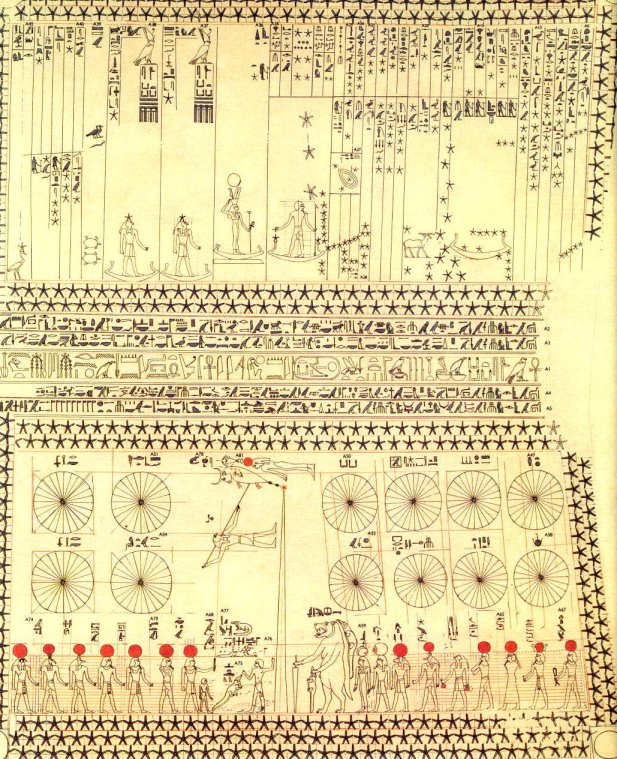
| Above, the astronomical ceiling from Chamber A, TT353; it is the
oldest astronomical presentation known - the next one was found in the
tomb of Sethi I. - and naturally, it is the only one in a private tomb (photo
taken from Dorman, 1991).
The astronomical ceiling measures approx. 3x3.6 m at its greatest
dimensions.
|
|
The ceiling of Chamber A is divided into two sections representing the
northern and the southern skies. The southern - upper part shown in the
picture above - is decorated with a list of decanal stars, as well as constellations of the southern
sky belonging to it like Orion and Sothis (Sopdet). Furthermore, the planets Jupiter, Saturn,
Mercury and Venus are shown and
associated deities who are traveling in small boats over the sky. Thus,
the southern ceiling marks the hours of the night.
The northern - lower part - shows constellations of the northern sky with the large bear
(Ursus major =
 msxtjw, Hannig,
Großes Deutsch-Ägyptisch, Mainz 2000, S. 561; depicted as a bull with an
oval body in which the name is written. The tail ends in 3 circles
connected by a line and the 3rd circle is located a the top of a tall
triangle) in the center. The
other constellations could not be identified. On the right and left of it
there are 8 or 4 circles shown and below them several deities each
carrying a sun disk towards the center of the picture. The inscriptions
associated with the circles mark the original monthly celebrations in the
lunar calendar, whereas the deities mark the original days of the lunar
month (after Meyer, 1982).
msxtjw, Hannig,
Großes Deutsch-Ägyptisch, Mainz 2000, S. 561; depicted as a bull with an
oval body in which the name is written. The tail ends in 3 circles
connected by a line and the 3rd circle is located a the top of a tall
triangle) in the center. The
other constellations could not be identified. On the right and left of it
there are 8 or 4 circles shown and below them several deities each
carrying a sun disk towards the center of the picture. The inscriptions
associated with the circles mark the original monthly celebrations in the
lunar calendar, whereas the deities mark the original days of the lunar
month (after Meyer, 1982).
The astronomical ceiling is divided along its east-west axis by a
text band composed of five registers. The central line which is wider
than the other four registers bears together the titles of Hatshepsut
and some titles as well as the name of Senenmut. The text reads from the
right to the left :
"Live, Horus powerful of kAs,
Two- Ladies flourishing of years, Horus-of-Gold divine of appearances,
king of Upper and Lower Egypt, Maat-ka-Ra, beloved of Amun-Ra, living;
the sealbearer of the king of Lower Egypt (sDAwtj-bitj),
the steward of Amun (jmj-rA pr n Jmn)
Senenmut, engendered of Ramose (Ra-ms),
justified, born of Hatnefret (@At-nfrt)."
|
| The fact that Senenmut and Hatshepsut are mentioned together in the
same line of text, which starts with "Live...", is
interpreted by Meyer (1982) in that way that Senenmut not only regards himself here as
"equivalent" to the queen, but also that he had reached the
highest point of his power or career when he built his 2nd tomb, TT353,
- because this inscription could not be kept secret. |
|
Directly on both sides of the entrance of the long passageway into the
Chamber A there is Senenmut depicted on the walls standing and adoring the
cartouches of Hatshepsut.
|
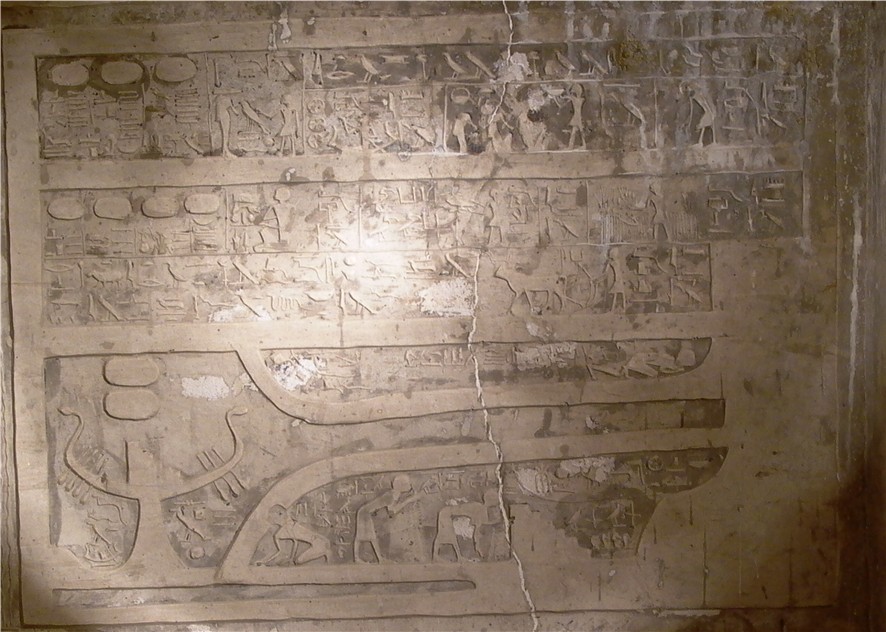
|
Directly above the passage which leads from chamber A to chamber B Senenmut
passes - in the picture shown above - through the "Fields of Hotep (Satisfaction)".
|
| Directly to the left of the entrance to Chamber A a
second passageway of about
25 m (43 stairs) descends to Chamber B. The entrance was cut in such a way
into the floor of Chamber A that the decoration of the western wall was
not disturbed. |
Chamber B is a rectangular room with a flat ceiling. The
chamber was left completely unfinished. There walls were roughly cut and
there has been no attempt to clean the walls or to close the cracks with
plaster.
As in Chamber A another passageway opens left from the entrance and
descends for about 10 m to the last Chamber C, whose doorway is approx. 96 m
from the uppermost step of the entire tomb. |
| In contrast to Chambers A and B, Chamber C has - in north-south direction -
a curved ceiling. The chamber is unfinished, but contrary to Chamber B the walls
had been prepared and smoothed, so that it was ready for the decoration. In the northeast corner of the
Chamber a shaft was hewn about 1.5 m deep into the rock, above this
shaft there are to two niches. |
| The decoration was never completed and work on the tomb
was obviously stopped rather suddenly. Only the faces had been destroyed in all representations,
Senenmut's name as well as the name of Hatshepsut were preserved. Dates with month and day
still visible on the walls - however without giving the year - show how
long the work iwas executed. |
|




![]() msxtjw, Hannig,
Großes Deutsch-Ägyptisch, Mainz 2000, S. 561; depicted as a bull with an
oval body in which the name is written. The tail ends in 3 circles
connected by a line and the 3rd circle is located a the top of a tall
triangle) in the center. The
other constellations could not be identified. On the right and left of it
there are 8 or 4 circles shown and below them several deities each
carrying a sun disk towards the center of the picture. The inscriptions
associated with the circles mark the original monthly celebrations in the
lunar calendar, whereas the deities mark the original days of the lunar
month (after Meyer, 1982).
msxtjw, Hannig,
Großes Deutsch-Ägyptisch, Mainz 2000, S. 561; depicted as a bull with an
oval body in which the name is written. The tail ends in 3 circles
connected by a line and the 3rd circle is located a the top of a tall
triangle) in the center. The
other constellations could not be identified. On the right and left of it
there are 8 or 4 circles shown and below them several deities each
carrying a sun disk towards the center of the picture. The inscriptions
associated with the circles mark the original monthly celebrations in the
lunar calendar, whereas the deities mark the original days of the lunar
month (after Meyer, 1982).